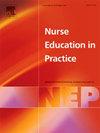自我调节学习与翻转课堂相结合的护理技能教学:一项随机对照研究
IF 3.3
3区 医学
Q1 NURSING
引用次数: 0
摘要
目的本研究考察自我调节学习活动与翻转课堂相结合是否能提高护理技能的表现。传统上,护理技能是通过课堂授课提供的,这是一种被动的学习形式。然而,研究表明,翻转课堂教学需要积极参与学习,对培养护理技能的能力更有效。当学生在课堂参与之前做好充分的准备时,可以进一步优化结果,这可以通过自我调节学习来实现。设计:随机平行组设计。方法将100名 五年级护生随机分为干预组(自主学习+翻转课堂教学,n = 50)和对照组(传统标准课堂教学,n = 50)。与基线测量相比,广义估计方程检验了干预对自我效能、自我调节学习和护理技能表现的影响。结果社会人口变量在组间没有差异。干预组在自我效能、自我调节学习和护理技能表现方面较基线水平的提高在16周时显著高于对照组(β = 6.10, p = 0.04和β = 11.74, p <; 0.01,β = 11.92, p <; 0.001)。结论将自我调节学习活动与翻转课堂相结合,不仅能提高护理技能的表现,还能提高自我效能感和自我调节学习能力。我们的研究结果表明,这种教学方法应被考虑应用于各种护理课程。本文章由计算机程序翻译,如有差异,请以英文原文为准。
An integrated self-regulated learning and flipped classroom approach for teaching nursing skills to undergraduate nursing students: A randomized controlled study
Aim
This study examined if self-regulated learning activities integrated with a flipped classroom approach improved performance of nursing skills.
Background
Traditionally, nursing skills are provided with classroom lectures, which is a passive form of learning. However, studies have demonstrated that flipped classroom teaching, which requires active engagement in learning, is more effective for developing competence in nursing skills. Outcomes can be further optimized when students adequately prepare prior to classroom participation, which can be accomplished through self-regulated learning.
Design
A randomized parallel group design.
Method
A total of 100 s-year nursing students were randomly assigned to the intervention group (self-regulated learning with flipped classroom teaching, n = 50) or the control group (traditional, standard classroom instruction, n = 50). Generalized estimating equations examined the effects of the intervention on measures of self-efficacy, self-regulated learning and performance of nursing skills at 16-weeks compared with baseline measures.
Outcomes
Socio-demographic variables did not differ between groups. Increases from baseline in self-efficacy, self-regulated learning and performance of nursing skills were significantly greater at 16-weeks for the intervention group compared with the control group (β = 6.10, p = 0.04 and β = 11.74, p < 0.01, β = 11.92, p < 0.001, respectively).
Conclusion
Integrating self-regulated learning activities with a flipped classroom approach not only improved performance of nursing skills but also enhanced self-efficacy and self-regulated learning. Our findings suggest this teaching approach should be considered as an application across various nursing courses.
求助全文
通过发布文献求助,成功后即可免费获取论文全文。
去求助
来源期刊

Nurse Education in Practice
NURSING-
CiteScore
5.40
自引率
9.40%
发文量
180
审稿时长
51 days
期刊介绍:
Nurse Education in Practice enables lecturers and practitioners to both share and disseminate evidence that demonstrates the actual practice of education as it is experienced in the realities of their respective work environments. It is supportive of new authors and will be at the forefront in publishing individual and collaborative papers that demonstrate the link between education and practice.
 求助内容:
求助内容: 应助结果提醒方式:
应助结果提醒方式:


